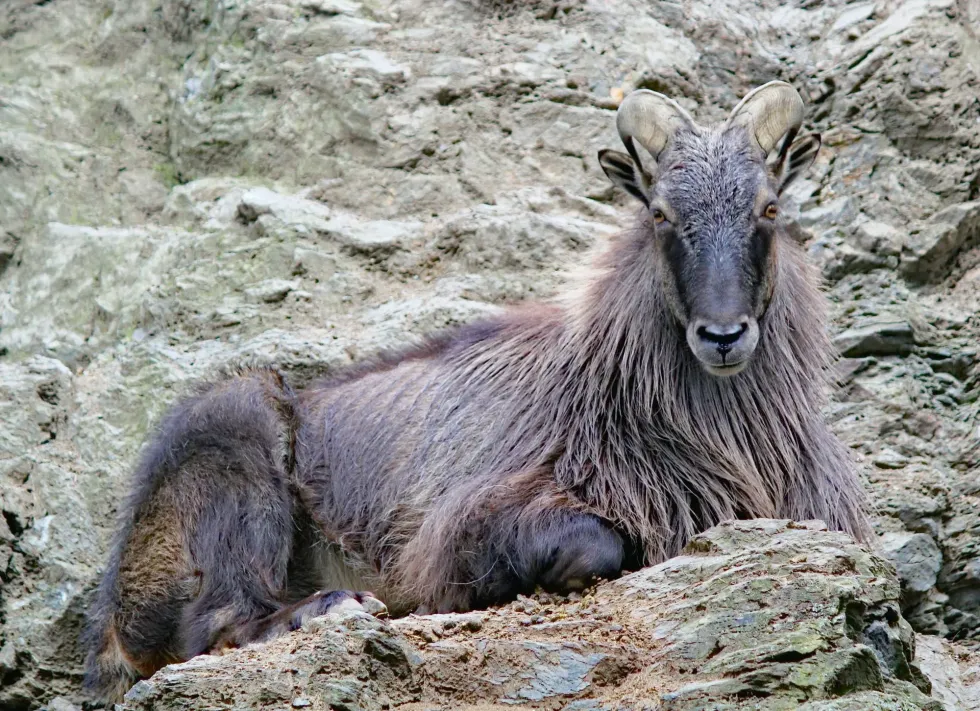The tahr is a wild goat species, endemic to the Himalayan ranges of Tibet, India, and Nepal. They were introduced to New Zealand, South Africa, and North America, mainly for hunting purposes.
There are three distinct species of the genus Hemitragus, the Himalayan tahr, the Nilgiri tahr, and the Arabian tahr of Oman. The males are larger than the females.
The Himalayan tahr (Hemitragus jemlahicus) is reddish-brown in color, the Nigiri tahrs of southern India are dark brown, while the smallest of the three species, the Arabian tahr is a beautiful blond. The Arabian tahr exists in small populations, covering a small area of the United Arab Emirates.
All three species of tahrs are Near Threatened according to the IUCN Red List, mainly because of excessive hunting and habitat loss. Keep on reading to learn more about intriguing tahr facts.
If you liked reading this article, check out mountain sheep facts and the mountain goat facts here on Kidadl!
Tahr Interesting Facts
What type of animal is a tahr?
A tahr is a wild goat species that belongs to the family Bovidae.
What class of animal does a tahr belong to?
The tahr belongs to the class Mammalia, just like sheep and African elephants.
How many tahrs are there in the world?
Although there is no record of the number of tahrs found in the world, these species of wild goat are considered to be highly Endangered because of excessive hunting.
Where does a tahr live?
The Himalayan tahr (Hemitragus jemlahicus) resides in the alpine forests of the Himalayas in Tibet, India, and Nepal. The Nilgiri tahrs are found in the southern parts of India, while the Arabian tahrs are endemic to northern Oman. They were also introduced to New Zealand, South Africa, and North America.
What is a tahr's habitat?
Tahrs generally prefer alpine forests of the elevated mountain ranges, with lush green vegetation and rocky terrain.
Who do tahrs live with?
Tahrs live in a herd of 10-15 individuals and lead a communal life.
How long does a tahr live?
The average lifespan of a Himalayan tahr ranges from 10-14 years in the wild and up to 21 years in captivity.
How do they reproduce?
The tahr is a polygamous animal and the males are competitive in nature. During the breeding season, the male tahr engages in duals with other males, to gain authority over the females. They undergo sexual reproduction with a gestation period of six to eight months, after which the females deliver a single baby.
What is their conservation status?
The tahr is listed as a Near Threatened species by the IUCN Red List.
Tahr Fun Facts
What do tahrs look like?

Tahrs are furry and resemble goats. These animals have thick curvy black horns. They have short legs and keratinized hooves. These hooves are flexible with the hard outer layer, which helps them with a smooth grip. They have small heads with short ears. The male Himalayan tahrs possess a silky mane with abundant fur.
How cute are they?
Tahrs look cute, however, their thick horns can appear to be quite intimidating.
How do they communicate?
Himalayan tahrs, as well as other tahr species, communicate using whistling cries, with which they alert other animals of any potential danger.
How big is a tahr?
The length of a Himalayan tahr is about 36-60 in (91-152 cm) and their height is 24-42 in (60-106 cm), similar to the Barbary sheep.
How fast can a tahr run?
No information is available on the speed of tahr.
How much does a tahr weigh?
The weight of a Himalayan tahr is about 176 lb (80 kg).
What are the male and female names of the species?
There are no sex-specific names given to the male and female species of tahr.
What would you call a baby tahr?
A baby tahr is called a kid.
What do they eat?
Their diet includes plants, mostly grass and leaves.
Are they loud?
These animals produce their characteristic whistling calls to alarm other animals, which appear to be loud in the hilly forests.
Would they make a good pet?
Tahrs are not suitable pets because of their thick coat and strong horns. They prefer dense forest vegetation in the hilly areas where their body has adapted to the climate.
Their shiny mane and furry coat help them to regulate their body temperature in the cold climate. Further, their declining population has made it against the law to hold them captive.
Did you know...
The Duke of Bedford offered 14 Himalayan tahrs to the New Zealand Government in 1904.
Tahrs eat throughout the daytime, during which they are most active.
Can you eat tahr?
The tahr animal of New Zealand can be eaten because they taste just like goats. Leopard, tiger, and wolves are their natural predators.
How many tahrs are left in the world?
There are fewer than 2000 tahrs left in the world.
Here at Kidadl, we have carefully created lots of interesting family-friendly animal facts for everyone to discover! Learn more about some other mammals from our takin facts, or plains zebra facts pages.
You can even occupy yourself at home by coloring in one of our free printable sheep coloring pages.









